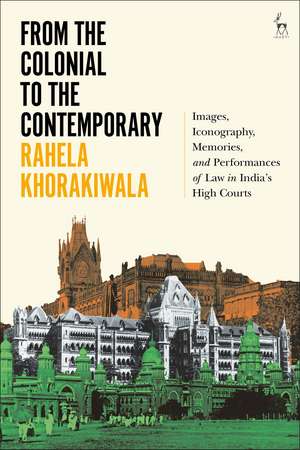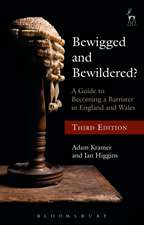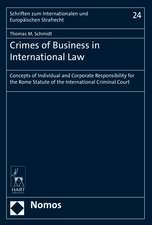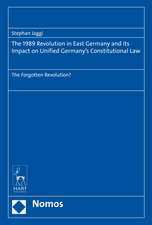From the Colonial to the Contemporary: Images, Iconography, Memories, and Performances of Law in India's High Courts
Autor Dr Rahela Khorakiwalaen Limba Engleză Paperback – 28 iul 2021
| Toate formatele și edițiile | Preț | Express |
|---|---|---|
| Paperback (1) | 265.18 lei 6-8 săpt. | |
| Bloomsbury Publishing – 28 iul 2021 | 265.18 lei 6-8 săpt. | |
| Hardback (1) | 541.61 lei 3-5 săpt. | |
| Bloomsbury Publishing – 8 ian 2020 | 541.61 lei 3-5 săpt. |
Preț: 265.18 lei
Preț vechi: 340.22 lei
-22% Nou
Puncte Express: 398
Preț estimativ în valută:
50.75€ • 52.58$ • 42.35£
50.75€ • 52.58$ • 42.35£
Carte tipărită la comandă
Livrare economică 21 martie-04 aprilie
Preluare comenzi: 021 569.72.76
Specificații
ISBN-13: 9781509953554
ISBN-10: 1509953558
Pagini: 296
Dimensiuni: 156 x 234 mm
Greutate: 0.42 kg
Editura: Bloomsbury Publishing
Colecția Hart Publishing
Locul publicării:London, United Kingdom
ISBN-10: 1509953558
Pagini: 296
Dimensiuni: 156 x 234 mm
Greutate: 0.42 kg
Editura: Bloomsbury Publishing
Colecția Hart Publishing
Locul publicării:London, United Kingdom
Caracteristici
Presents a topical and incisive theory and ethnography of courthouses in India, and specifically of the three most striking High Court buildings, Bombay, Madras and Calcutta
Notă biografică
Rahela Khorakiwala is an independent researcher based in Mumbai, India.
Cuprins
1. Framing the Research I. Introduction II. Law, Visuality and Culture III. The Three Courts: Law, History and Memory IV. Visual Justice: Images of Justice in Courts V. Method of Study VI. Field Experience VII. Chapter Plan VIII. Conclusion 2. The Visual Field of Law I. Introduction II. Iconography and Semiotics III. Relationship between Law and the Image IV. Images of Justice of the Court and in the Courtroom V. Judicial Iconography of Courts VI. Judicial Iconography and the Statue of Justice VII. Conclusion 3. The Calcutta High Court I. Introduction II. History of the Calcutta High Court III. Establishment of the Calcutta High Court Building IV. Architecture and Judicial Iconography of the Calcutta High CourtV. Specific Customs Prevalent in the Calcutta High Court VI. Conclusion 4. The Bombay High Court I. Introduction II. History of the Bombay High Court III. Establishment of the Bombay High Court Building IV. Layout of the Bombay High Court V. Judicial Iconography of the Bombay High Court VI. Conclusion 5. The Madras High Court I. Introduction II. History of the Madras High Court III. Establishment of the Madras High Court Building IV. Architecture and Judicial Iconography of the Madras High CourtV. Specific Customs Prevalent in the Madras High Court VI. Conclusion 6. Attributes of Justice I. Introduction II. The Name of the High Courts III. Language IV. Forms of Addressing the Court V. Dress VI. Photography, Video-recording, Live Telecasting and Courtroom Sketches VII. Ceremony and Ritual in Court Proceedings VIII. Conclusion 7. Conclusion I. Law and the Regulation of its Image II. Access to Justice III. Law as Heritage IV. Law, History and Memory V. Apocryphal Histories and Revised Narratives
Recenzii
The author offers penetrating insights into the behaviour of the various actors involved, notably judges, lawyers and court administrators ... The relationship between law, memory and history is explored with academic rigour as is the role of judicial iconography in the maintenance of the dignity and majesty of the law ... the book deserves to be received with approbation.





